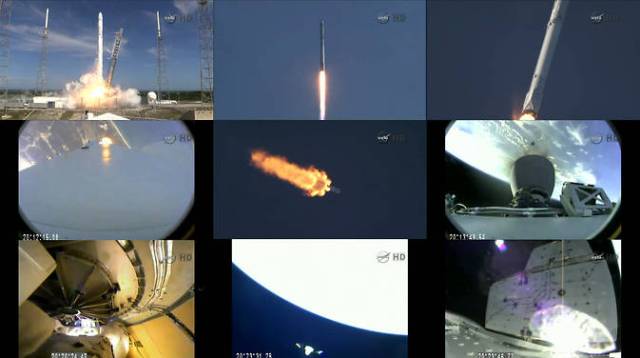Apr 17 2015
On Tuesday, April 14, 2015, SpaceX’s Dragon spacecraft lifted from Space Launch Complex 40 at Cape Canaveral Air Force Station based in Florida, beginning SpaceX’s sixth cargo delivery to resupply cargo to the International Space Station (ISS) via NASA’s Commercial Resupply Services contract. The launch took place at 4:10 pm EDT. Among the two tons of cargo were science payloads that will help robotic explorers and NASA astronauts to prepare for future missions to Mars.
 The series of images shows the journey of the SpaceX Falcon 9 rocket and Dragon spacecraft from its launch at 4:10 p.m. EDT Tuesday, April 14 from Space Launch Complex 40 at Cape Canaveral Air Force Station in Florida, to solar array deployment.
The series of images shows the journey of the SpaceX Falcon 9 rocket and Dragon spacecraft from its launch at 4:10 p.m. EDT Tuesday, April 14 from Space Launch Complex 40 at Cape Canaveral Air Force Station in Florida, to solar array deployment.
The cargo in the Dragon spacecraft will support about 40 of the 250 science and research analyses. These studies will be carried out during Expeditions 43 and 44, and will also include human research studies for a one-year mission in space to be carried out by NASA astronaut Scott Kelly.
The research will support experiments in Earth science, physical science, biology, and biotechnology. Such studies improve human life and advance future space exploration. These include:
- Research to enhance the understanding of bone cells, which could give way to novel therapies for muscle wasting conditions and osteoporosis. ‘Osteo-4’ explores the impact of microgravity on osteocyte function. These cells are present inside the mineralized bone and are capable of perceiving mechanical forces; however, this phenomenon is still unknown. Through Osteo-4, researchers will able to study the changes occurring in the genetic expression and physical appearance of mouse bone cells in microgravity.
- Analysis of potential techniques, which can be used to counteract the cell damage occurring in a microgravity environment. This Cell Shape and Expression research program will offer an experimental model, which will be able to emphasize the link between gene expression, cell shape and microgravity. This could also provide pharmacological means to offset the cell damage induced by microgravity.
- Studies into vision changes experienced by astronauts - The Dragon spacecraft will also supply hardware to support Fluid Shifts, a one-year crew research. Over 50% of American astronauts suffer from vision changes as well as changes in portions of their eyes while embarking on long-duration spaceflight. This Fluid Shifts research determines the amount of fluid moving from the lower part of the body to the upper part, and also measures the effect of these movements on the head’s fluid pressure as well as the alterations in eye structures and vision.
- Testing of a new material with potential applications as synthetic muscle - Robots can carry out repetitive tasks, which would be too dangerous or challenging for humans. Using synthetic muscle to build robots may provide human-like capabilities to these machines. However, the material must be strong enough to endure the space environment. This research evaluates the radiation resistance of a Synthetic Muscle, which expands and contracts similar to real muscles. It is an electroactivepolymer developed by RasLabs.
SpaceX's Dragon spacecraft will also supply the hardware required for deploying two International Docking Adapters, which are planned for delivery on upcoming SpaceX missions. When these adapters are deployed, they will allow commercial crew spacecraft to land at the ISS.
The space station includes a robotic arm, which will be used by European Space Agency (ESA) astronaut Samantha Cristoforetti to grapple the Dragon spacecraft to the space station at 7 a.m. Friday, April 17 2015. The mission will be assisted by Expedition 43 Commander Terry Virts from NASA.
Approximately five weeks later, the Dragon spacecraft will leave the space station and dock in the Pacific Ocean west of Baja California. It will return over 3,000 lbs of hardware, science, spacewalk tools, and crew supplies.
"Five years ago this week, President Obama toured the same SpaceX launch pad used today to send supplies, research and technology development to the ISS. Back then, SpaceX hadn’t even made its first orbital flight. Today, it’s making regular flights to the space station and is one of two American companies, along with The Boeing Company, that will return the ability to launch NASA astronauts to the ISS from U.S. soil and land them back in the United States. That’s a lot of progress in the last five years, with even more to come in the next five", said NASA Administrator Charles Bolden.
The ISS is a combination of human innovation, science and technology and helps in demonstrating novel technologies and innovative breakthroughs, which are otherwise not possible on Earth. Since November 2000, many international and commercial spacecraft and over 200 people have visited the space station, which continues to remain a platform for NASA's future space mission exploration, including missions to Mars and asteroid.